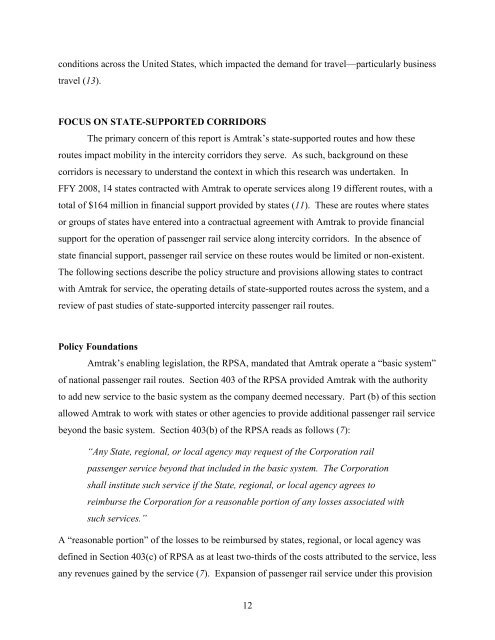Measuring the Benefits of Intercity Passenger Rail: A Study
Measuring the Benefits of Intercity Passenger Rail: A Study
Measuring the Benefits of Intercity Passenger Rail: A Study
You also want an ePaper? Increase the reach of your titles
YUMPU automatically turns print PDFs into web optimized ePapers that Google loves.
conditions across <strong>the</strong> United States, which impacted <strong>the</strong> demand for travel—particularly business<br />
travel (13).<br />
FOCUS ON STATE-SUPPORTED CORRIDORS<br />
The primary concern <strong>of</strong> this report is Amtrak’s state-supported routes and how <strong>the</strong>se<br />
routes impact mobility in <strong>the</strong> intercity corridors <strong>the</strong>y serve. As such, background on <strong>the</strong>se<br />
corridors is necessary to understand <strong>the</strong> context in which this research was undertaken. In<br />
FFY 2008, 14 states contracted with Amtrak to operate services along 19 different routes, with a<br />
total <strong>of</strong> $164 million in financial support provided by states (11). These are routes where states<br />
or groups <strong>of</strong> states have entered into a contractual agreement with Amtrak to provide financial<br />
support for <strong>the</strong> operation <strong>of</strong> passenger rail service along intercity corridors. In <strong>the</strong> absence <strong>of</strong><br />
state financial support, passenger rail service on <strong>the</strong>se routes would be limited or non-existent.<br />
The following sections describe <strong>the</strong> policy structure and provisions allowing states to contract<br />
with Amtrak for service, <strong>the</strong> operating details <strong>of</strong> state-supported routes across <strong>the</strong> system, and a<br />
review <strong>of</strong> past studies <strong>of</strong> state-supported intercity passenger rail routes.<br />
Policy Foundations<br />
Amtrak’s enabling legislation, <strong>the</strong> RPSA, mandated that Amtrak operate a “basic system”<br />
<strong>of</strong> national passenger rail routes. Section 403 <strong>of</strong> <strong>the</strong> RPSA provided Amtrak with <strong>the</strong> authority<br />
to add new service to <strong>the</strong> basic system as <strong>the</strong> company deemed necessary. Part (b) <strong>of</strong> this section<br />
allowed Amtrak to work with states or o<strong>the</strong>r agencies to provide additional passenger rail service<br />
beyond <strong>the</strong> basic system. Section 403(b) <strong>of</strong> <strong>the</strong> RPSA reads as follows (7):<br />
“Any State, regional, or local agency may request <strong>of</strong> <strong>the</strong> Corporation rail<br />
passenger service beyond that included in <strong>the</strong> basic system. The Corporation<br />
shall institute such service if <strong>the</strong> State, regional, or local agency agrees to<br />
reimburse <strong>the</strong> Corporation for a reasonable portion <strong>of</strong> any losses associated with<br />
such services.”<br />
A “reasonable portion” <strong>of</strong> <strong>the</strong> losses to be reimbursed by states, regional, or local agency was<br />
defined in Section 403(c) <strong>of</strong> RPSA as at least two-thirds <strong>of</strong> <strong>the</strong> costs attributed to <strong>the</strong> service, less<br />
any revenues gained by <strong>the</strong> service (7). Expansion <strong>of</strong> passenger rail service under this provision<br />
12
















